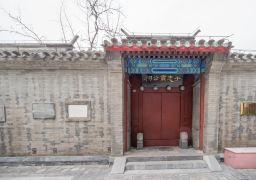About 15 kilometers away from the urban area of Yiwu, in the north of Yiting Town on flat ground, a cliff rises abruptly from the earth. This peculiar cliff resembles a crouching lion, looking up and stretching northward. The cliff is approximately 50 meters long and 13 meters high, and this lion-like rock formation is known as Tongshan Rock. At the high-raised lion’s head, there is an open lion’s mouth, nearly 30 meters wide, resembling an oral cavity that extends 18 meters inward. As early as the Southern Song Dynasty, people utilized the cliff’s mouth and the platform in front to construct three majestic temples in the front, middle, and rear. Regrettably, as time passed and scenes changed, the original magnificent landscape of the Lion Rock was repeatedly destroyed, and Tongshan Rock became nearly dormant. To meet the needs of tourism and sightseeing, in the 1980s, people rebuilt the Mahavira Hall, Hu Gong Hall, and a hexagonal pavilion on the cliff’s back within the cliff’s mouth. In 1996, the Jade Buddha Hall was also completed, housing a 1.6-meter-tall Jade Buddha weighing about 400 kilograms. The traditional Double Ninth Festival is a lively time for Tongshan Rock. Tourists and pilgrims from hundreds of miles around flock to this place, with the number of visitors sometimes reaching twenty to thirty thousand. Opening times are subject to the actual opening status on the day.
Tongshan Rock
About 15 kilometers away from the urban area of Yiwu, in the north of Yiting Town on flat ground, a [...]









